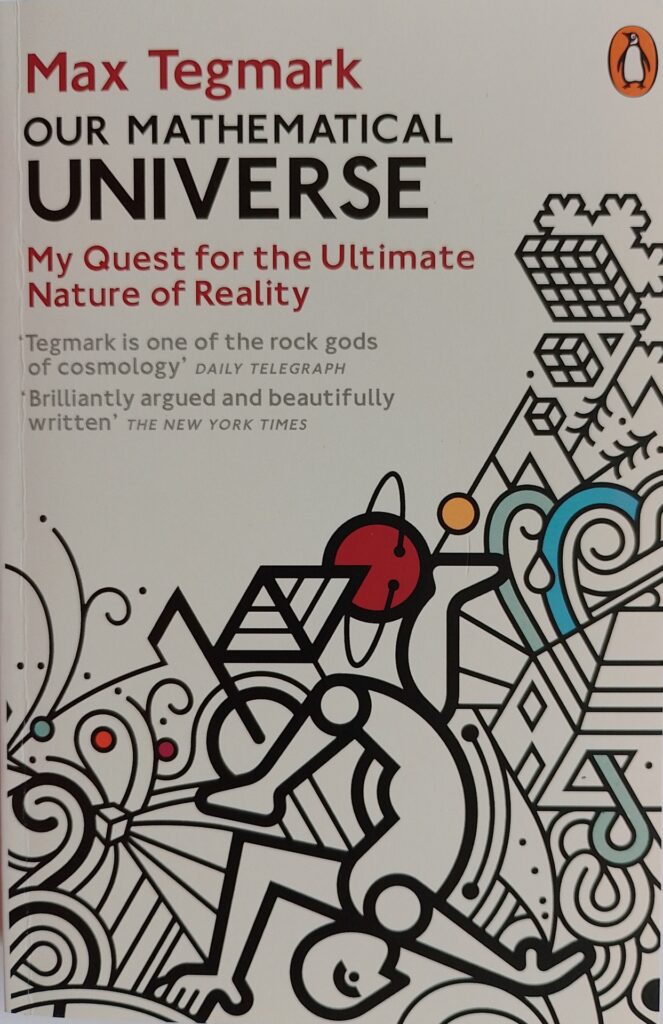First published 2014. Penguin paperback, 2015, pp 421, c.160,000 words.
Tegmark is a very articulate physics communicator. On television he is excellent in explaining complex phenomena in an accessible fashion, and he always seems to have a twinkle in his eye. The same personality shines through this book. The opening five chapters are a master-class in laying out the basics of cosmology to the layman. After that the book develops Tegmark’s thesis that everything is fundamentally a mathematical construct, with theories that he describes as ‘controversial’ or ‘extremely controversial’ [p13].
A man goes into a pub to ask for directions. The barman says: ‘turn left out of here, then at The Kings Arms go left. When you get to The Royal Oak turn right, straight on past The Swan, and it’s next left near The Red Lion.’ A priest in the bar then pipes up: ‘No, you’d better turn left out of here, go as far as Our Lady the Virgin and turn right. At the synagogue, go left, then right at the mosque, and then right again at St. Augustine’s and you’ll be right there.’ ‘No, no,’ says a builder, ‘go right out of here and left at the electrician’s…’ This book has that same feel, and I almost gave up reading at several points. Tegmark presumably spends his working life dealing with mathematics and therefor sees the whole of creation in that light. However he is not a mathematician. It is an interesting case, but he ends up building an all-encompassing structure on very dodgy foundations, from both a physics perspective and a mathematical one. Also he fails to see what to others with a different perspective is obvious. For example, about Fig 10.8 [p265], he writes: the left panel ‘has no relation between its entities, so there is nothing to distinguish any one entity from another. This means that this mathematical structure has no properties whatsoever except its cardinality… a pretty boring structure.’ An artist would be entitled to disagree that the left panel is more boring than the other two and would likely perceive plenty of relations between its entities.
To be fair, Tegmark is not shy in showing us those shifty-sandy underpinnings of his theories, but his enthusiasm lets him get carried away with the beauty of the edifice he is erecting. For starters we don’t know much about 95% of what our part of the universe is, labelling it Dark Matter and Dark Energy. Secondly, so far no one has been able to reconcile quantum theory and relativity. As he illustrates in Fig 10.1 [p246], the boundaries of physics keep changing, and what is mainstream one day can fall out of favour the next. All these theories were useful in their time in helping us understand and make use of the material around us. In Table 10.1 [p252] he lists thirty-two numbers that he considers are required to compute ‘every fundamental property of nature ever measured’ but offers no explanation of why thirty-two numbers and even fails to mention that we don’t know everything about cosmology or particle physics, so surely the list is incomplete.
Tegmark loves multiverses, proposing four levels, each of which is infinite in extent. He piles infinity on infinity, rather skating over the problem of using infinity in mathematics, as explored by Godel, amongst others. Indeed, some mathematicians would argue that mathematics is incomplete and provably unprovable at a very fundamental level: see for example Marcus Du Sautoy’s What We Cannot Know. Mathematicians are also in disagreement on whether mathematics is invented or discovered: a rather crucial point.
By the end, Tegmark is delving deep into meta-physical territory: ‘I feel…’, ‘As far as I’m concerned…’, ‘My guess is…’, ‘I believe…’ [p382]. As Russell shows in his History of Western Philosophy, one very able chap is able to construct a theory explaining the universe, and that comes to be the accepted wisdom of the age until some equally clever person comes along, points out the flaws in the structure and then proceeds to construct a new tower of thought. No doubt Tegmark would argue that mathematics is different from faith, but those foundations…
The writing is mostly very clear. However, for this edition some of the diagrams and pictures have been shrunk or badly reproduced, e.g. Fig 3.5 [p55]. Also the cover has been changed, but the text that refers to it has not been edited, e.g. on p59. Presumably the first edition showed the classic colourful cosmic microwave background image – a subject which Tegmark seems to have made a substantial mainstream contribution to. I’m with the professor who advised him not to spend too much time in the father reaches of speculation. There is still much exciting work to be done close to home in physics without some of the most able dreaming up unprovable theories.
I was glad to have persisted to the end because the final chapter returns to more accessible territory. Here he explores existential threats to humanity. On the way he touches on the Fermi Paradox, giving a lucid explanation of why we should hope that we don’t discover life on Mars.
Wikipedia biography of Tegmark: https://en.wikipedia.org/wiki/Max_Tegmark
Wikipedia summary of the book: https://en.wikipedia.org/wiki/Our_Mathematical_Universe
Others’ reviews of the book: https://www.goodreads.com/book/show/19395553-our-mathematical-universe?ref=nav_sb_ss_1_16
© William John Graham, September 2023

